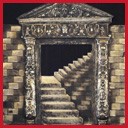Materializing Immaculacy in Sixteenth-Century Tyrol
Marian Devotion and the Material Poetics of Silver
Identifiers (Article)
Abstract
The Innsbruck sepulchral chapel of Habsburg prince and sovereign of Tyrol, Archduke Ferdinand II (1529–1595), accommodates a generously sized Marian altarpiece, the focus of this study. Chased reliefs crafted from solid silver are mounted on ebony-veneered panels with ivory accentuating the moldings that frame the pictorial fields. This restrained material palette conjures a vision of the Virgin Immaculate and results in a display of silver on a monumental scale. In contrast to the Archduke’s extensive Kunst- and Wunderkammer at nearby Ambras Castle, the altarpiece has received relatively little scholarly attention. Drawing from diverse fields such as theology, botany, and music, this paper delves into the altarpiece's material and pictorial complexity and discusses the multifaceted layers of meaning that underpin the creation of this remarkable work. Considered within the context of the sepulchral chapel, hierarchies of matter, color, and space convey the Virgin’s singular status and her role as primary intercessor. Jesuit thought and new patterns of Marian devotion, not least under the influence of Peter Canisius, play a pivotal role in this context, which is framed against the backdrop of Habsburg piety and Counter-Reformation efforts.
The altarpiece meaningfully embodies the theme of the Virgin Mary as mirror of virtue, in the tradition of speculum sine macula (a mirror without stain). At the same time, the silver’s tendency to tarnish and blacken draws parallels to the ambiguous tensions and complexities surrounding her immaculacy and theological beauty. This study also highlights the slippage between artistic practice and the broader context of Tyrolean silver mining and minting activity. At a time when the value of coined silver was becoming uncertain and its purity questioned, the altarpiece’s tarnished materiality demonstrates the degree to which moral and material virtue were subject to negotiation and open to ambiguous interpretation. Therefore, this paper also illuminates and investigates period concepts of material immaculacy, purity, and preciousness, which stand at the intersection of theological ideals, financial motivations, and artistic ambition.
Statistics







